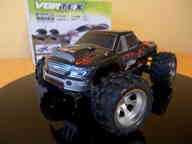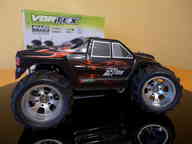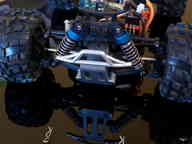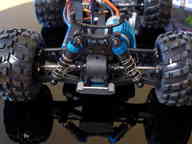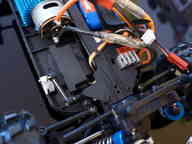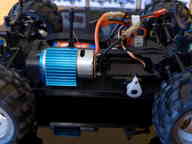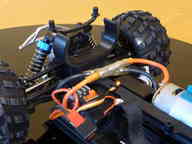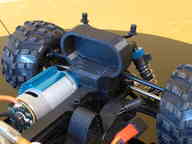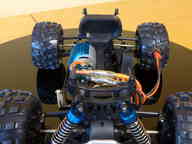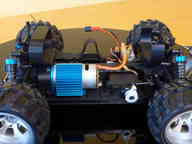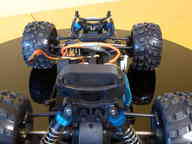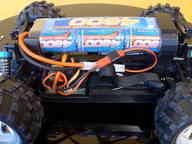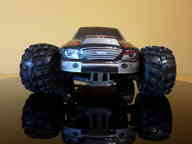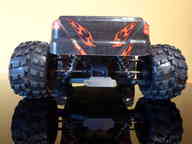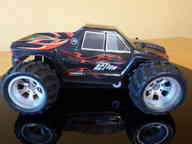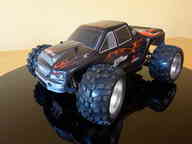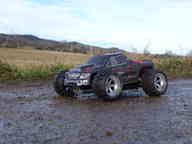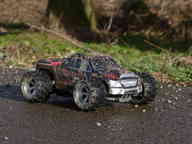RC 4x4 models (EN)
WLtoys A979 unboxing
2015-10-25: WLtoys Vortex-A979 unboxing
We have another RC "cruise missile", this time it is the WLtoys Vortex model A979 . It is a 1/18 scale model of a monster truck.
The car came packed in a semitransparent box. Cut off two fixation tapes from under the car and pull everything out, including accessories. Of course there is a 2.4GHz transmitter, charger (power converter and ballanced charger for Li-Po), a manual and a wheel wrench. Nothing more, nothing less.
The bodywork is made of durable Lexan and it shall represent a normal pick-up truck. However, as it is always with monster trucks – a stock car's bodywork is modified and placed onto an extreme chassis, which is completely unrelated to the bodywork of the original vehicle. In this case, however, the chassis has a relatively low clearance.
When I compare HG P402 (imitating Mercedes G63), Feiyue-03 (representing a desert buggy) and Vortex-A979 , I'm not exactly sure what was the original vehicle supposed to be. I certainly haven't seen in reality anything quite like it yet. However, one can't deny a certain elegance and attractive appearance of the Vortex-A979 .
The body needs to be taken off to get to the battery, chassis and other components. The body is held by four clips, which are very rigid at least on my Vortex-A979 . I need to use tools to pull them off. On the HG P402 the clips are much easier to pull off without piercing the fingers :) . The bodywork itself is very light. During recording of the video I needed just a little amount of "magic mana" to cast a correct spell to make the bodywork levitate above the chassis :) . It was easy, not like lifting a 9 ton truck ;) .
Fortunately, you do not need to take off the body at every opportunity. With just a little bit of skill you can get to the master switch, as well as to the charging connector of the battery without removing the body at all.
The chassis has independent wheels suspension with coil springs. The rear axle's springs have added washers to make them tougher, which should result in a more oversteer behavior under power (yeah, better drifting! :) ). Suspension arms on all wheels are made of plastic and they are visibly flexing and bending during springing action.
The connecting shaft between the axles is plastic (to partially eliminate stress due to cornering, because Vortex-A979 has no center differential), but all half-axles are made of metal shafts as well as the joints in the wheels. Both axles have an open differential.
Chassis design gives the car great stability when cornering. The approach and departure angles are almost 90 degrees, the car can climb to an almost vertical wall.
The tyres are made of very soft rubber with a strong off-road pattern. They stick very well to the ground and happily make rubber lines on the floor on every wheel-spin occasion :) .
The car has a relatively large turning radius – which is good for fast driving, it could be easier than with Feiyue-03 . The servo behaves very well and smoothly.
As you will see in detail in the video, the pinion gear on the motor is made of brass metal, sprocket on the drive shaft between the axles is plastic. Again, this would probably not be a problem to 3D-print a spare one from ABS or PET if needed. So far so good, all plastic gears hold on all my cars. If you loosen the bottom screw holding the gear housing, pay attention to the electric motor's magnet. Magnetic field will catch the screw and hide it beneath the motor and it does not want to come out :) .
The motor is expected to get a really hard time on the track, so it is fitted with a passive aluminum heatsink :) . Vortex-A979 is incredibly fast, even so that the wheels can generate lift, almost causing the car to fly, as you can see at the end of the video. Please note, that it was not a trick – the thing was literaly about to take off. I'd rather instinctively throttled back and began to pray so that it doesn't fly out the window :) .
Waterproof?
An interesting question is "waterproof-ness". On the GearBest's web site, I saw a note that the car IS waterproof. That must have been a typo, because definitely no submarine can be made of this car. The ESC and motor are almost on the frontline when it comes to wading. I'm certainly not planning to do my popular diving experiments, at least until I prepare a video of the test drives. But showering could be theoretically possible, as well as driving on wet roads. Yet the manual warned against the use of the car in any wet environments, and especially near water areas. When I imagine how the water wave went through the whole Feiyue-03 ... ouch :).
Transmitter
The transmitter needs to be fed with your own four AA cells as usually. By the way, the four AA cells seen in my videos are the same, I just swap them among transmitters.
A little warning – unlike previous cars, this one came with the master switch in the off position. The switch is clearly marked on the ESC. So remember to check the switch when you turn on the radio, plug the car battery and still nothing happens. Also, the car does not like when you turn on the car before turning on the transmitter. They won't talk to each other. You must turn on the radio first and then the car.
Battery
The battery is a 7.4V Li-Po with a capacity of 1.1Ah. It is equipped with a special connector I haven't seen at any RC model yet. The manual states, that the car will run for at least 10 minutes, which is quite short. However, slow and short drives during recording of the video took at least 30 minutes and the battery was still fine. We'll see how this thing behaves under load on a model circuit. Of course, there is a big difference in energy consumption between slow and full-throttle driving.
There is one more possibility how to solve low battery capacity. Under the bodywork, there is sufficient space for mounting a classic six-cell NiMH battery. Although that would significantly increase the weight of the entire vehicle, it would also greatly improve its operating range. I just need to design and 3D-print some mounts :) and possibly fit stiffer coil springs.
Battery charger has two LEDs – the green one means "powered", the red one means "charging". When the red LED goes off, the charger is satisfied with its work and considers the battery charged. I like this design more than by the Feiyue-03 charger, where one needs to examine the color of its dual-color LED.
What kind of terrain is the vehicle intended for?
The manual says that the car manages to drive well on hard surfaces, sand and grass land. This is due to the fact that the car has a low ground clearance, it would have difficulties overcoming rough bumps. Moreover, open differentials and fast gear ratio virtually eliminate any slow and precise rock crawling possibility. On the contrary, the car is well suited for asphalt and flat solid surfaces. It is an autocross or rally special with enhanced stability.
If it is to run 50 km/h as stated on the box, I was expecting absolutely precise steering and axle geometry. Therefore, I was very surprised with manufacturing inaccuracies on the chassis. It is the worst manufactured car of all 3 RC toys I have here. There is a considerable amount of loosenes both in steering (virtually all of the joints) and in suspension, all can be clearly seen in the video. Moreover, there are significant eccentricities of rotating parts e.g. joint axle driveshafts. I wonder how these manufacturing inaccuracies will affect the behavior of the car while driving. But we'll see after first road tests.
2016-01-09: High capacity battery upgrade
If you read my previous article carefully, you might have found a notice, that there has been a possibility of mounting a big 6-cell NiMH battery pack into this tiny car. I wasn't joking...
What do you need?
- A 3D printer ;)
- A pair of connectors: a BEC connector same as on the original battery, PSH (sometimes called "Tamiya") connector opposite of the NiMH battery pack
Using some 3D creation software, design two parts – front and rear battery pack holder. That's a very simple exercise, you only need to be careful about precisely measured dimensions on the car. 3D Print it, preferably from ABS, PETG etc. I wouldn´t recommend PLA in this case as the rear holder is very close to the electric motor, which can get hot when running, and thus the PLA will degrade.
I decided to mount both holders on the car's differential casings using the already present screws. That's a noninvasive solution, which can be removed anytime. Also the antenna must be pulled out from the standing pole and left lying on the side.
Solder the two battery connectors together, I had the BEC with a pair of wires, so I used them.
Results:
- The battery pack's nominal capacity is at least 4 time bigger than the original pack. That means much longer running time to get the right feel of this fast car (that's why I'm doing this). That also allows me to finally record some off-road video.
- The battery pack is much heavier compared to the original LiPol pack. That means, the car now "sits" more on the ground. I like that ;) . We'll see the influence on the car's behaviour in the upcoming video.
- And finally some very interesting result, that I didn't expect in such a light car. My NiMH battery pack is not capable of providing enough short-circuit current compared to the original LiPol pack. It means, the ESC gets restarted when you press instantly full-throttle (within a few milliseconds). The electric motor acts as short-circuit for a short moment, thus battery voltage drops under such level, which is no more acceptable for the ESC to run. The car stops.
If you press full-throttle a little more slowly (250 milliseconds or so), that's enough to move the electric motor and prevent battery voltage from dropping too much. If I use a LiPol battery pack from the HG P402 (same 6-cell size), this does not happen, because these LiPol's are a much harder power source.
2016-01-10: Vortex outdoor
Today we made a first outdoor test with the WLtoys Vortex-A979 . The results are not surprising:
- The car's ability to get dirty is phenomenal :) . Look at the photos – the first one shows the car just after entering an off-road path. The second one shows the car after doing some fast driving on a muddy tarmac path and the last one shows the car on its way back home (tyres can clean themself pretty fast). The problem is, the car is not only full of mud from the outside, but mostly inside including all the electronics. That's a bad result, the central part of the chassis must be added with some skirts to prevent dirt and water getting directly on the motor and the ESC.
- The tyres' grip is excelent. They stick to almost any surface. That also means the car understeers heavily. Moreover, if you keep throttle inside a corner, the lack of central differential results in a much wider turn radius. However, you can force the car to slide into a corner by braking (the rear gets lifted and the car makes an oversteer slide). The new heavy battery pack helps this behaviour.
- Even though I tried the same terrain as with my Tatra 130 when testing a prototype 3D printed tyre , the WLtoys Vortex-A979 was much worse driving off-road. Open axle differentials and low clearance really elliminate drive through any harder terrain. Moreover, the electric motor does not have that much force to dig through deep mud. So keep in mind, that the right track for this car is a sandy flat area – a flat rally course seems to be a good choice (as I expected at the beginning). Still, we are yet to find a suitable track to make a nice video teaser ;) .
- The car can really "suck" the 4.6Ah NiMH battery within 80 minutes of continuous driving. Compared to the previous battery – that's a good result, the battery holders are really worth it. The driver finally has some time to learn the car's behaviour. Still, driving full-throttle can lower the NiMH battery's voltage in such a bad way, that the ESC gets reset improperly and the only way around is to switch the car off and on again.
2016-01-21: Half-dead battery pack :)
Regarding my last notice about the ESC cutting out at full-throttle: after trying another battery pack it turned out, that my 4.6Ah NiMH was already half-dead. Even my Tatra 130 doesn't like that battery pack anymore. That's why the voltage was dropping so much. With a good-condition NiMH battery pack, the car flies just like with the original battery ;) .






